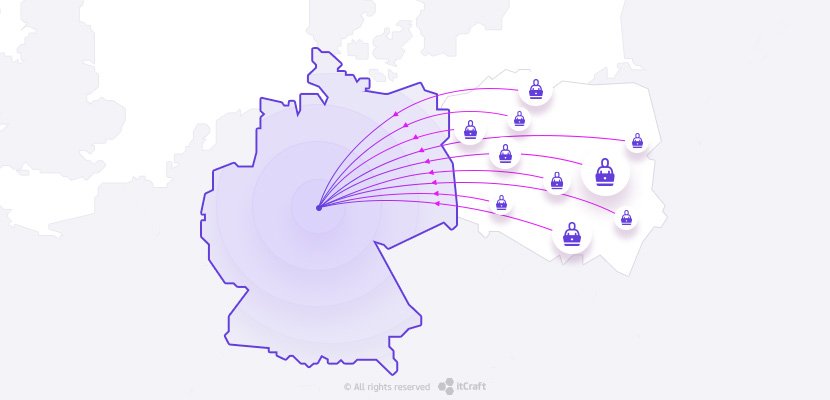Women in the IT industry

Alexa Trachim

Paulina Chmielewska

Unequal representation of gender is a problem in many industries. IT seems to be one of the most masculine sectors – but it’s slowly changing. At itCraft, 25% of employees are women. And despite stereotypes, they do not only work in HR, marketing or administration. We hire talented female workers in all departments – including design and development.
Table of contents
- Women in technology – statistics
- Why are there more men than women in tech?
- Challenges for women in tech
- Why do we need more female tech specialists?
- How to conquer these issues?
– So what are the main problems we should conquer? - What is changing now?
- What is the future of women in tech?
Still, many tech companies have only a couple of women hired here and there, remaining typical manly workplaces. We’ve been wondering what are the current challenges for women in tech industry and how to tackle them to bring more diversity to the software development environment.
Women in technology – statistics
Let’s take a look at the situation in the US, United Kingdom and our homeland Poland. In all these countries, women are always outnumbered in IT companies. According to Womenintech.co.uk:
“Only one-in-six tech specialists in the UK are women, only one-in-ten are IT leaders and, worse still, despite significant growth in the number of women working in IT roles, female representation in the technology sector has stalled over the last ten years (…)”
We can’t talk about the tech sector without mentioning the overall employment gap. In the United States, only 47% of all employees are women. The research from 2015 claims that women hold only 25% of the positions in information technology companies. These inequalities don’t change even though the job market’s overall situation was constantly improving since 1990.
In our own country, 30% of employees in tech companies are women. The gender gap is caused by many troubling misconceptions about the industry and hurtful stereotypes that were not only repeated by men for years but most importantly – they are still believed by women.
Why are there more men than women in tech?
We should start from the very beginning – and go back to high school. Studies show that female students usually get better grades than males. But for some reason, computer science degrees at universities are mostly occupied by men – they are 82% of students and that’s one of the biggest disproportions when it comes to college courses.
Some blame stereotypical roles burden on men and women – girls are told from a very young age they should be submissive and agreeable. Toys and hobbies we propose to them don’t include activities that promote logical thinking, math skills and interest in computer science or tech in general. Career paths are still promoted based on stereotypical gender capabilities. Add to that that tech sector workplaces are considered male-dominated and oftentimes sexists – many women are worried about entering the IT industry.
Challenges for women in tech
There are many obstacles that women will stumble upon when pursuing a career in programming or any other area of mobile or web development. And fighting them might be exhausting. The tech sector is already evolving, but it’s slow and rigid.
The gender pay gap in the tech sector is claimed to be smaller than in other industries, but it is still present. Women working in IT companies frequently feel like they need to continually prove their worth to their colleagues and superiors, but they get paid less for the same amount of work. That is a source of frustration and why women drop their tech careers more often than men.
When it comes to newly created startups, men will more likely ask their male friends to join the business than their female peers. That’s because hiring managers prefer to give a job to a person with similar interests and world views. In the tech industry where female workers are underrepresented, men are more likely to become leaders and employees within tech companies – the chances for the opposite gender are drastically unequal.
Speaking of leadership, statistics show that in the United States, less than 20% of executive positions in tech are occupied by women. In Europe, that number is a little bit above 11%. Since kindergarten, through high school and computer science studies – women are discouraged from following their dreams of becoming engineers, developers and other technical specialists. No wonder that they are less likely to become a CTO or CIO. In most international tech corporations like Apple, Dell, Facebook, Google, or Intel, the majority of employees are men.
For years women were discriminated in almost any industry and this problem is still very much alive. In 2017, 50% of women reported they’d experienced gender-based discrimination. But this number grew significantly in computer science-related companies (74%) and workplaces where men were the dominant workforce (78%). Over one-fifth of women in tech claim that their gender is a barrier in achieving professional success and more than one-third said their companies have a problem with sexual harassment.
Some sources also mention the lack of role models that don’t inspire young women to start a career in the tech industry. And that situation is caused directly because of all the reasons mentioned above. Not to mention maternity leave policies that sometimes can be unfriendly and unsupportive. Employers that can offer flexibility and help for women working in their offices gain trust and loyalty.
Why do we need more female tech specialists?
Studies show that male-dominant companies care less about gender diversity. That’s a mistake since eliminating such inequalities provides a better work environment for all. In such workplaces, discrimination is lower and a need to constantly prove oneself is decreased.
Apparently, when women take over the leadership in tech industry brands, the valuation in first and last funding becomes significantly higher – 64% and 49%. Female employees working in website and app development are claimed to make better decisions and be more creative. And these definitely are the characteristics every team can benefit from.
Technology firms included in the Fortune 500 list that had a majority of female board members experienced more than 40% of return on sales compared to less diverse entities. Women tend to provide better communication skills, exciting ideas and exquisite morale to the table, which should definitely be appreciated by tech industry companies.
How to conquer these issues?
First of all, we need to take care of gender diversity in any workplace, not just tech. Women need equal opportunities to climb the career ladder and gain leadership. Only then will we be able to experience all the advantages of every gender in our daily work.
At the moment, women in tech excel in areas like HR, project management and marketing. Still, for many, this industry is dedicated only to men and is perceived as problematic to get into. Even typical female positions in technology-based companies are not visible and widely marketed. If women knew about opportunities they could get by working in this sector, they would more likely approach them.
And we can definitely say that we would also experience more women in development, design, quality assurance, and other tech positions in this case. Why? For example, in our country, more than 40% of women hired in software houses were previously working in a completely different sector. For men, that’s only 30%. The conclusion is that women often have more courage and motivation to change their career paths and pursue something else from what they did before.
There’s a need for proper assessment and monitoring for all employees. It is not only to prevent women working in tech from leaving their jobs, but also to evaluate those workers who showcase leadership and progression to propose them promotions, raises, or new ways to accelerate their professional growth.
The most significant change we need to see is the mindset in our society. Prejudice against women and unfair stereotypes have to end. That doesn’t mean only accepting women in technology companies, but giving them the same conditions to work, learn and advance in the workplace.
So what are the main problems we should conquer?
Women know exactly what they want. “Equality” is a voluminous term, but concrete demands should be met to give female employees a similar status to their male co-workers. Of course, this list includes the most burning issues, but there are many other problems that we described above that need to be addressed.
Compensation
The number we see on a paycheck is considered one of the main factors of professional success. Men are statistically more satisfied with their salaries than women – and that’s because female specialists get paid less for the same job. Reducing the gender pay gap is a must.
Work/Life balance
Men negotiate flexible work conditions (remote work, paid leave options, etc.) more often than women. Still, female employees do not only work as many hours as men, but they are also responsible for the “second shift” at home – cleaning, cooking and other chores. Women often have to leave their careers to raise children because their employers don’t give them a chance to reconcile private life and work.
Purpose
Everyone wants to do something meaningful at their jobs. Feeling that one has an impact not only on the company’s revenue but also on the community and society makes people work harder, be more creative and solve problems better. These opportunities should be assigned equally – women should not be destined to perform unimportant tasks only.
Advancement
Women face many challenges at work and in life. They need to balance their careers, motherhood and private lives – so they might forget about an opportunity for promotion or raise. Presenting clear paths they can follow in their professional growth could change that. Recognizing their value for the company and their achievements are also welcomed.
What is changing now?
The change is slowly entering the corridors of Silicon Valley giants, international corporations and smaller startups. The brands we’ve mentioned above – Google, Facebook, Apple and Intel – want to include more women into their operations and become truly gender diverse.
They want to recognize their female employees and give them proper credit for their merits. Also, they promised to reduce the pay gap between men and women working in their companies. Some companies try to minimize bias towards women among their male workers and include their female colleagues in various teams.
Interestingly, 39% of the technology-based firms reported they experienced problems with finding the right candidates for positions that required STEM (Science, Technology, Engineering, Mathematics) type of education and experience. The demand for talent within the industry is enormous and hiring more women could be a remedy.
Right now, a lot of initiatives are created to help women succeed in tech. They focus on education, mentoring aspiring women who want to become role models for the next generations of women in IT, fighting inequitable stereotypes and building networks for female specialists in the industry. Some organizations include Girls in Tech, Girls Who Code, League of Women Coders, Women 2.0 and Women Who Code.
At the moment, women also start to attain leadership in the most prominent businesses. They can become inspiration and motivation to every girl and woman that wants to succeed in IT or any other sector. Ellen Pao used to be the CEO of Reddit, Sheryl Sandberg holds a position of COO at Facebook and the CFO of Google is Ruth Porat. It proves that these realms – once overrun exclusively by men – can be managed by women, too.
What is the future of women in tech?
Many authorities in gender equality say that women will start to gain endless possibilities in the upcoming years. Workplaces appreciate their value and insight they can provide into a very masculine environment. The IT industry needs to inspire girls from a very young age and encourage them to apply to science-related college degrees. Providing mentorship and praising women in high-level positions can also work wonders.
Women’s role can’t be underestimated when it comes to designing and developing software and hardware that will be inclusive and available for all. How can it be, if the industry is so homogenous? The society consists of more than just men. Everyone should be represented and treated in the same way.
The change might be hard to effectuate, but it is very much needed in our evolving world. Gender equality can bring only good things to the IT industry and the world. Maybe it will take 5 years or 10, but we can already observe that the situation is evolving. At itCraft, we agree with the direction of this transformation and our policy includes support for diversity and anti-discrimination rules. We gladly hire women in all of our teams and we make use of their talents and skills. Hopefully, other software houses will follow our lead.
If you would like to work with our experts on your next application development project – hit the contact button. We will gladly help you implement your business strategy to succeed in any field you want to.




